This one comes up a lot when we discuss the dire realities of the average intelligence levels seen in Sub-Saharan African countries: If the mean IQs are 70, wouldn’t that mean half the population is retarded? That can’t be right, something is wrong with the data. Russell Warne wrote a blogpost about this back in 2020. His point was that though an IQ below 70 or 75 is usually included in the definition of mental retardation, it is not the sole criterion anymore. For instance, this review of mental retardation from 2015 notes:
Intelligence is the general mental capacity that involves reasoning, planning, solving problems, thinking abstractly, comprehending complex ideas, learning efficiently, and learning from experience (AAIDD, 2010). Historically, intellectual disability (previously termed “mental retardation”) has been defined by significant cognitive deficits—which has been established through a standardized measure of intelligence, in particular, with an IQ score of below 70 (two standard deviations below the mean of 100 in the population)—and also by significant deficits in functional and adaptive skills. Adaptive skills involve the ability to carry out age-appropriate daily life activities. Two different systems for classifying intellectual disability (ID) used in the United States are that of the American Association on Intellectual and Developmental Disabilities (AAIDD) and the Diagnostic and Statistical Manual of Mental Disorders, 5th Edition (DSM-5), which is published by the American Psychiatric Association. Both of these systems classify severity of ID according to the levels of support needed to achieve an individual’s optimal personal functioning (see Table 9-1).
Their table:

I want to expand on Warne’s point. When people think of retarded people, they mostly have in mind someone who has Down syndrome, or a similar severe genetic disorder. These are people who have some major genetic error, and who suffer a profound intellectual disability because of this. They usually suffer from some kind of syndrome, which is why it’s usually called syndromic retardation. But the more important point is that Down syndrome does not just make your intelligence very low, it also causes other behavioral defects. As such, people with Down syndrome are not representative of people with <70 IQ. The other class of people with very low IQs are people who are simply on the left tail of their normal distribution. They do not have any major genetic defects or suffered from trauma, they were just unlucky with the dice throw of the normal genetic variation in intelligence. You can think of it as throwing 6 standard dice. The expected sum is 21, but it is possible to get only 6, or get as much as 36. People who don’t have any syndromes or trauma, but still have low IQs, are people who rolled a lot of 1’s in their genetic lottery.
This point is important with regards to race differences. As Arthur Jensen wrote back in 1972 about why he came to study race differences in intelligence:
While I was engrossed in my research on serial learning, one of my graduate students who worked as a school psychologist brought to my attention what appeared to be a challenging problem for a researcher on human learning. Besides, it was a part of my personal philosophy that a scientist should try to bring his technical expertise to bear on practical as well as theoretical problems; and here, it seemed, was a worthy practical problem. My student said he was looking for a good culture-free or culture- fair test of intelligence and had not been able to find one. All the tests he used, whether they were claimed to be culture-fair or not, were in considerable agreement with respect to children diagnosed as educationally mentally retarded (EMR), by which they were assigned to special small classes offering a different instructional program from that in the regular classes. To qualify for this special treatment, children had to have IQs below 75 as well as lagging far behind their age-mates in scholastic performance. My student, who had examined many of these backward pupils himself, had gained the impression that the tests were quite valid in their assessments of white middle-class children but not of minority lower-class children. Many of the latter, despite IQs below 75 and markedly poor scholastic performance, did not seem nearly as retarded as the white middle-class children with comparable IQs and scholastic records. Middle-class white children with IQs in the EMR range generally appeared more retarded than the minority children who were in special classes. Using nonverbal rather than verbal tests did not appreciably alter the problem. I confirmed my student s observations for myself by observing EM R children in their classes and on the playground and by discussing their characteristics with a number of teachers and school psychologists. My student’s observations proved reliable. EMR children who were called ‘culturally disadvantaged’, as contrasted with middle-class EMR children, appeared much brighter socially and on the playgound, often being quite indistinguishable in every way from children of normal IQ except in their scholastic performance and in their scores on a variety of standard IQ tests. Middle-class white children diagnosed as EMR, on the other hand, though they consituted a much smaller percentage of the EMR classes, usually appeared to be more mentally retarded all round and not just in their performance in scholastic subjects and IQ tests. I asked myself, how could one devise a testing procedure that would reveal this distinction so that it could be brought under closer study and not depend upon casual observations and impressions.
The explanation for this mystery turned out not to be that the tests were biased (not measuring properly), but that a larger fraction of the White kids have syndromic retardation, i.e., large genetic defects or serious trauma that result in very low intelligence and also a host of other problems. The Black kids with low IQs, however, were predominantly just the left tail of their normal distribution, called familial retardation. If the cut-off IQ for getting into the EMR (special education class) is 70 IQ, then about 16% of Black kids will be there compared to about 2% of the White kids (you can figure out these numbers using this tool):
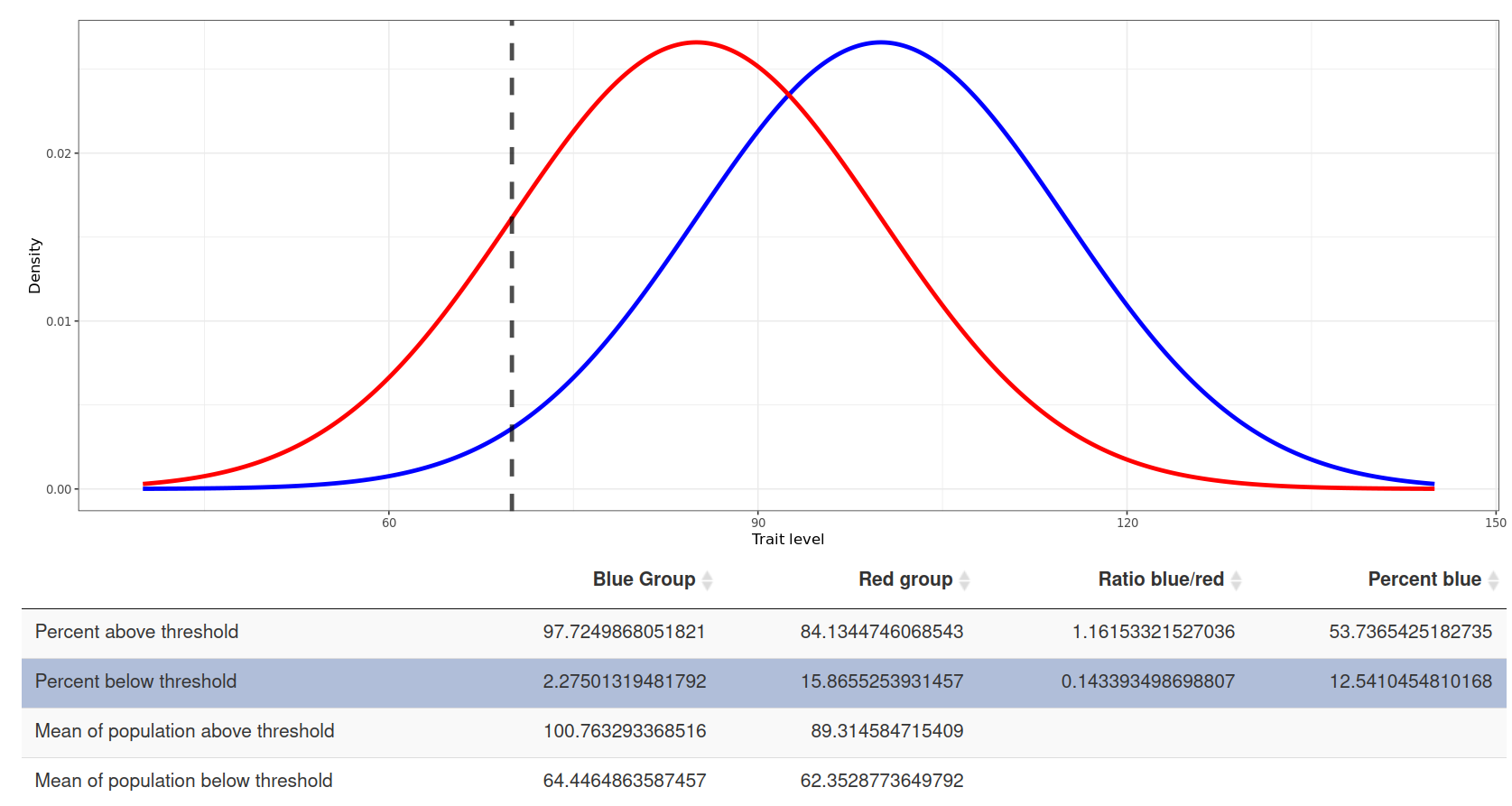
Aside from the normal curves, there’s a small group of children who have these rare syndromes, and they will then result in a small hump on the left tail of the distribution:

The figure is from Jensen’s famous 1969 article.
Now we can see how this relates to the African intelligence scores. Africans in Africa do very poorly on intelligence tests, scoring about 70. But they behave relatively normally. They are not clearly retarded like the White children in special education classes, who often suffer from one syndrome or another. Africans in Africa are simply, as a group, unlucky with their genetic dice throw compared with the rest of humanity. Whether to call half their population retarded depends on how you define retardation. As Warne wrote, modern definitions are not only based on intelligence levels, so by this definition, half of Africans would not be retarded, their rate would be about the same as the western. Of course, the word retard is now very insulting, so avoiding it for that reason is also sensible, though not a matter of scientific accuracy.
This left tail bump is actually important for understanding the genetic basis of intelligence because it leads to a prediction: if someone has syndromic retardation, then since this is mostly a random error, their siblings should be of about average intelligence. But if someone has familial retardation, then their siblings are also likely to be quite low intelligence, though not as low: regression towards to the mean upwards. It looks like this, again from Jensen 1969:
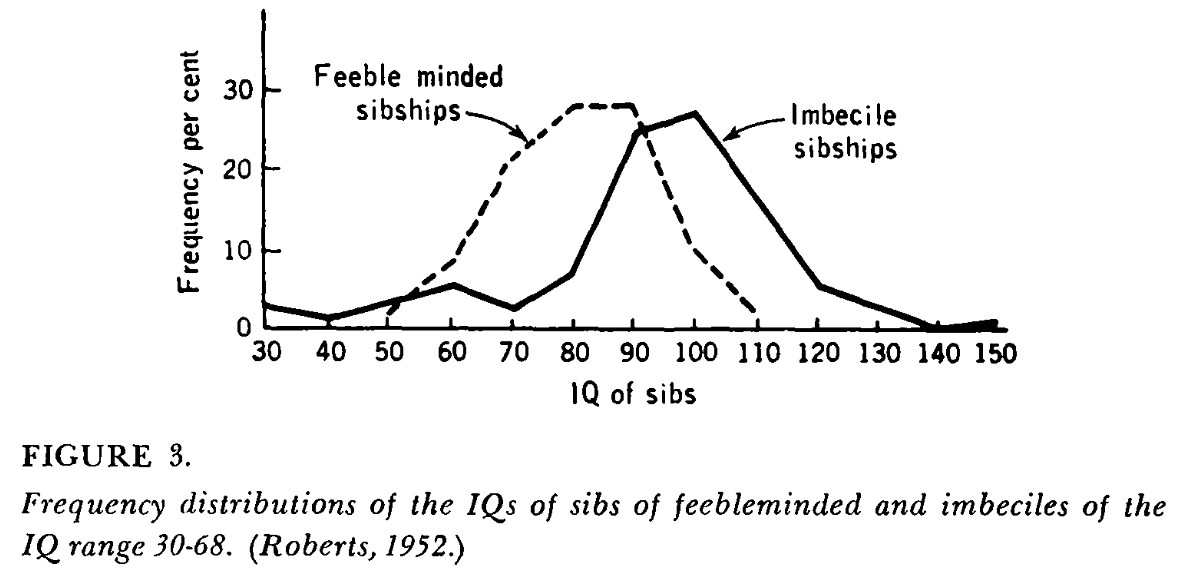
This is a strong prediction from a genetic model of intelligence, and was one of the pieces of evidence available already back in the 1950s. Jensen wrote a long article in 1970 setting out this theory. This finding has also been replicated with modern data. Here’s siblings of Swedish and Israeli children with mild ID (intellectual disability, i.e., retardation in the new euphemism):
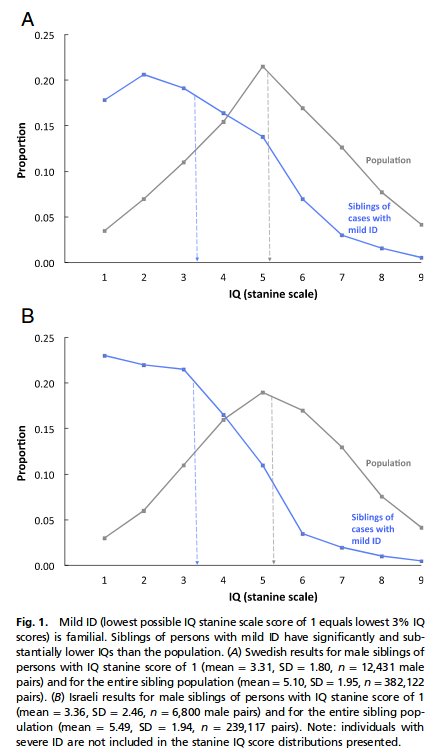
So their siblings are also scoring quite low on the army tests, but not as well. Similarly, for co-twins:
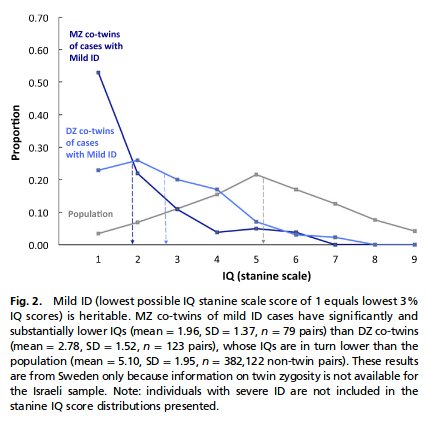
But when we look at the siblings of persons with severe retardation, the pattern is different:
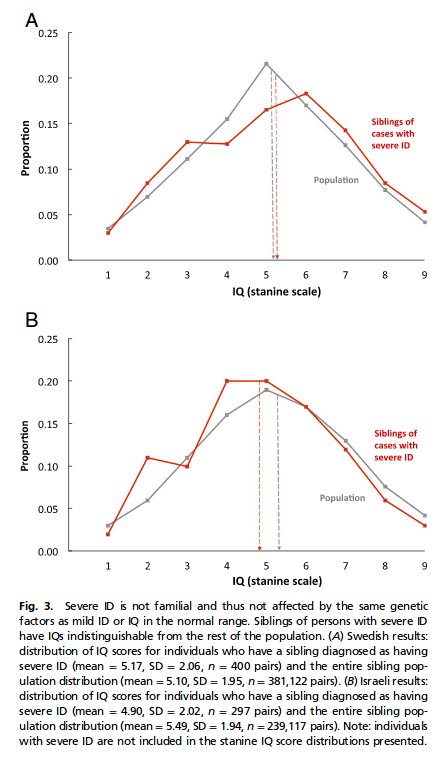
Their siblings are close to normal intelligence. That’s because almost all cases of severe retardation are caused by syndromes, whereas milder cases of retardation are caused by a bad dice throw with the regular genes.
So, to recap. African intelligence levels around 70 IQ are not like kids in a typical western country’s special education class. These kids often suffer from severe genetic disorders, or birth trauma. Their behavior is abnormal because of this aside from their low intelligence. African intelligence levels are low due to a combination of unlucky genetic dice throw (from our perspective!), and environmental deficits from poor nutrition, bad education, and diseases. Contrary to what is often claimed, hereditarians do not think African IQs are solely low due to genetic differences. The model is that about 10 IQ is due to bad environments, and 20 IQ is due to low polygenic scores for intelligence. As such, the between group heritability for western vs. African intelligence is estimated at about 67%, so there is room for improvement. As such, we should expect African national IQs to converge to about 80 in the coming decades everything else equal. Ironically, the main factor that could prevent this is the mass emigration of high intelligence Africans into western countries, thus depriving their countries of their elites. This is what we are currently seeing from countries like Nigeria (Igbo elites). Another possibility is that dysgenics will be faster in African countries, thus potentially canceling out their intelligence gains from environmental improvements by further lowering their polygenic scores for intelligence. Dysgenics by country is not well studied, so we simply don’t know what is going on here.

